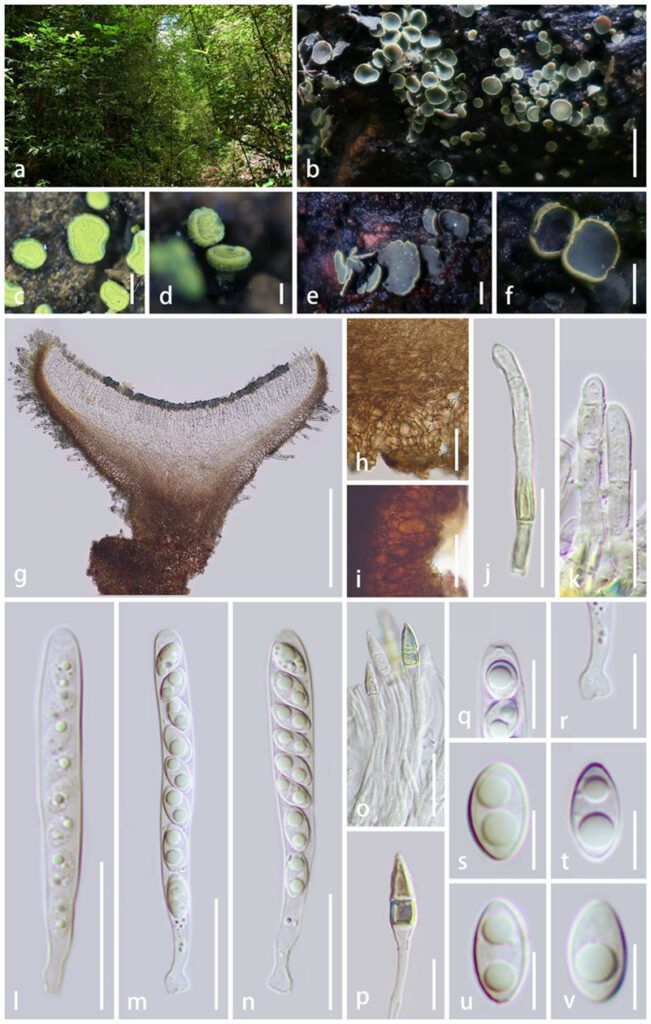Diplocarpa constans H.L. Su & Q. Zhao Fig. 1
MycoBank number: MB 559713; Index Fungorum number: IF 559713; Facesoffungi number: FoF 11440;
Etymology: The specific epithet refers to its negative ionomidotic reaction, which is different from two known species of Diplocarpa.
Saprobic on decayed stems. Sexual morph: Apothecia 2–5 mm in diam, up to 2 mm high when fresh, superficial, closely scattered, discoid to shallow cupulate, slightly leathery, shortly stipitate without a common base. Receptacle discoid to cupulate, greyish-green when fresh, light green when dry, surface entirely and densely clothed with short and bright green hairs, excipulum with a negative ionomidotic reaction. Margin slightly involute to flat, light green, with abundantly light green short hairs. Hairs 25–50 × 3–5 µm (x̄ = 35 × 4 µm, n = 17), clavate with rounded apex, smooth, thick-walled, septate, hyaline at the top, green at the base. Stipitipellis 65–105 µm (x̄ = 80 µm, n = 12) thick, dark brownish, 5.8–32.1 × 4.5–16.4 µm (x̄ = 15.2 × 9.0 µm, n = 44), cells of textura angularis, with hairs at the outmost flanks. Ectal excipulum 25–45 µm (x̄ = 35 µm, n = 13), dark brownish, with hairs at the outmost flanks, hyaline to light brownish at upper flanks, light brown to brownish, 8.4–39.5 × 4.2–23.6 µm (x̄ = 16.3 × 11.3 µm, n = 48), slightly thick-walled cells of textura angularis. Medullary excipulum 50–195 µm (x̄ = 95 µm, n = 21), brownish, 3.1–14.7 × 1.5–7.3 µm (x̄ = 4.3 × 7.3 µm, n = 51), thick-walled cells of textura angularis. Hymenium 70–105 µm (x̄ = 90 µm, n = 10), slightly concave to flat, slightly smooth, dark olive-green when fresh, yellowish green when dry. Paraphyses 1.0–2.3 µm (x̄ = 1.5 µm, n = 42) in middle, longer than asci, filiform, unbranched, smooth, thin-walled, septate, with conspicuous tips of 17.1–22.1(–25.6) × (4.2–)4.5–5.6(–5.7) µm (x̄ = 20.4 × 5.2 µm, n = 15), fusoid, 1–3-septate, terminal and secondary cells yellowish green to olive-green when mature, other cells hyaline. Asci (57–)59–74(–75) × 6–8(–9) µm (x̄ = 65 × 7 µm, n = 21), unitunicate, uniseriate, 8-spored, hyaline, clavate, inoperculate, rounded apex, wall apically thickened and laterally thin, with a ocular chamber, slightly tapered base, aporhynchous, inamyloid. Ascospores (154/4/2) (6.8–)7.3–9.9(–10.9) × (3.3–)3.7–5.0(–5.4) µm, (x̄ = 8.4 × 4.4µm, Q = 1.4–2.5, Q = 1.94±0.22), ellipsoid with rounded ends, slightly smooth, thin-walled, aseptate, hyaline, with 1–2 polar oil guttules. Asexual morph: Unknown.
Material examined:— China, Yunnan, Ailao Mountains, alt. 2428 m, on bark of a dead branch, 2 September 2021, H.L. Su, SHL224 (HKAS 124025, holotype); ibid., alt. 2434 m, on a dead bark, 1 September 2021, H.L. Su, SHL247 (HKAS 124026, paratype).

FIGURE 1. Diplocarpa constans (HKAS***, holotype) a Habitat. b–f Typical mature apothecia. g Vertical section of the apothecium. h Section of the excipulum. i Section of the stipitipellis. j, k Hairs. l–n Asci. o Paraphyses. p Apex of a paraphysis. q Apex of an ascus. r Base of an ascus. s–v Ascospores. Scale bars: b = 1cm, c–f = 2mm, g = 200 µm, h–i = 50 µm, j–o = 20 µm, p–r = 10 µm, s–v = 5 µm
